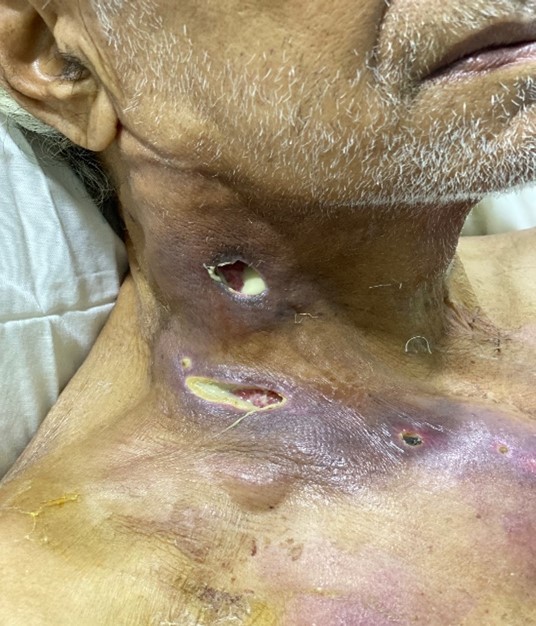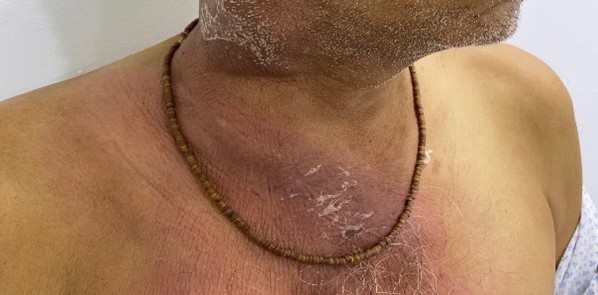A Case Report on Lelliottia Amnigena 2 Infections in Humans
M3 India Newsdesk Apr 22, 2024
Small cell carcinoma (SCC) of the oral cavity is a rare and highly aggressive malignancy. The case discussed in this article highlights the challenges associated with managing advanced small-cell carcinoma and the importance of microbiological identification for optimal antibiotic selection.
Small Cell Carcinoma (SCC)
Small cell carcinoma (SCC) is characterised by rapid growth, early metastasis, and poor prognosis [1]. Early diagnosis and aggressive treatment are crucial for improving patient outcomes.
The case report in this article describes the management of a complex case in a 75-year-old male with a large, aggressive small-cell carcinoma of the right lower alveolus. The patient underwent extensive surgery with multi-tissue resection, reconstruction, and lymph node dissection.
A post-operative neck wound infection necessitated culture-directed antibiotic therapy.
The case
A 75-year-old male with no significant medical history presented with a one-month history of painful swelling over the right lower jaw. Examination revealed a 4x3 cm verrucous growth involving the right lower alveolus, extending from the last molar to the canine region. The floor of the mouth and lower labial mucosa on the right side were also involved. A small submental lymph node was palpable on the right side.
Diagnosis
Laboratory findings (elevated white blood cells), C reactive protein 24 mg/dl suggested a possible acute infection. Biopsy confirmed poorly differentiated small cell carcinoma. CT scan revealed a large (4.5 x 2.5 x 3.5 cm) lesion eroding the right anterior mandible and involving right submandibular lymph nodes.
The final diagnosis was T4aN2bM0 small cell carcinoma of the right lower alveolus, indicating an advanced stage with regional lymph node involvement (American Joint Committee on Cancer Staging System).
Treatment
The patient underwent extensive surgery, including:
- Wide excision of right buccal mucosa, labial mucosa, lingual mucosa, and overlying skin.
- Right segmental mandibulectomy.
- Modified radical neck dissection on the right and selective neck dissection on the left.
- Reconstruction with a free fibula flap, pectoralis major flap, and split-thickness skin graft.
- Tracheostomy for breathing support.
Post-operatively, the patient received broad-spectrum antibiotics (Metronidazole and Ceftriaxone) for presumed surgical site infection. However, the patient developed a neck wound infection with pus discharge. Culture and sensitivity testing by the Vitek system identified Lelliottia amnigena 2 a rare bacterium, resistant to all tested antibiotics except Trimethoprim/Sulfamethoxazole.
Based on the culture results, the initial antibiotics were discontinued, and the patient was started on Trimethoprim/Sulfamethoxazole. Subsequently, the infection subsided, and the wound was re-sutured. The patient was then discharged.

Click to view sensitive image
Image-1 wound on the right side of the neck

Image-2 After treatment on follow-up
Discussion
This case demonstrates the aggressive nature of small cell carcinoma of the oral cavity. The extensive surgical approach, including multi-tissue resection, reconstruction, and lymph node dissection, reflects the need for comprehensive treatment in such cases.
- Post-surgical infections are a significant complication after head and neck surgery.
- Identifying the causative organism through culture and sensitivity testing is crucial for selecting appropriate antibiotics.
- In this unique case, Lelliottia amnigena 2 was identified as the causative agent of the post-surgical infection.
- Lelliottia amnigena 2 is a gram-negative, facultative anaerobic bacillus typically isolated from soil and water sources [2].
- While rarely reported, it has been associated with human infections, including urinary tract infections and lung infections [2,3].
- However, its role in surgical site infections is not well documented. Notably, the initial broad-spectrum antibiotics were ineffective, highlighting the importance of culture-directed therapy.
- Trimethoprim/Sulfamethoxazole, demonstrating in-vitro susceptibility, proved successful in resolving the infection.
Conclusion
This case report emphasises the challenges associated with managing advanced small cell carcinoma of the oral cavity. It underscores the importance of a multidisciplinary approach, including extensive surgery, reconstruction, and culture-directed antibiotic therapy for post-surgical infections.
Disclaimer- The views and opinions expressed in this article are those of the author and do not necessarily reflect the official policy or position of M3 India.
About the author of this article: Dr Mohmed Soeb Jankhwala is an Associate Professor in the Department of Microbiology at Nootan Medical College and Research Center, Sankalchand Patel University, Visnagar, Gujarat.
Dr Shubhra Sharma is a practising Head & Neck Surgical Oncologist at HCG Hospital, Jaipur
-
Exclusive Write-ups & Webinars by KOLs
-
Daily Quiz by specialty
-
Paid Market Research Surveys
-
Case discussions, News & Journals' summaries